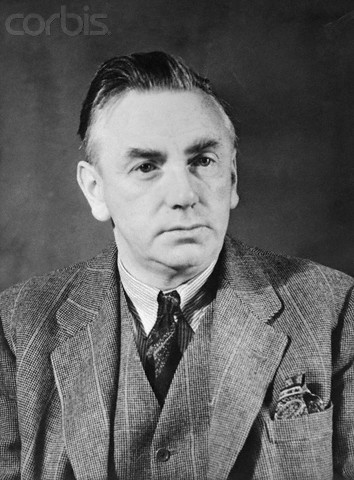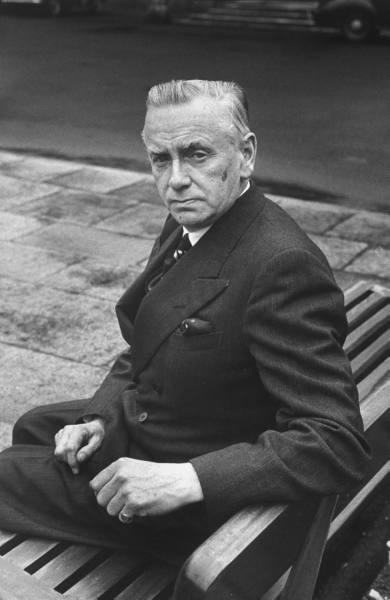<Back to Index>
- Paleontologist Othenio Abel, 1875
- Painter Léon Joseph Florentin Bonnat, 1833
- 2nd Taoiseach of the Republic of Ireland John Aloysius Costello, 1891
PAGE SPONSOR


John Aloysius Costello (Irish: Seán Alabhaois Mac Coisdealbha; 20 June 1891 – 5 January 1976), a successful barrister, was one of the main legal advisors to the government of the Irish Free State after independence, Attorney General of Ireland from 1926 – 1932 and Taoiseach from 1948 – 1951 and 1954 – 1957.
John A. Costello was born on 20 June 1891, in Dublin.
Educated at St Josephs Christian Brothers School in Fairview, North
Dublin, where future taoiseach Charles Haughey later attended, and at University College Dublin, he graduated with a degree in modern languages and law. He studied at King's Inns to
become a barrister, winning the Victoria Prize there in 1913 and 1914.
Costello was called to the bar in 1914 and practised as a barrister
until 1922 In 1922 Costello joined the staff of the Attorney General in the newly established Irish Free State. Three years later he was called to the inner bar and the following year, 1926, he became Attorney-General to the Cumann na nGaedhael government, led by W.T. Cosgrave. While serving in this position he represented Ireland at Imperial Conferences and League of Nations meetings. He was also elected a Bencher of the Honourable Society of King's Inns. Costello lost his position as Attorney-General when Fianna Fáil came to power in 1932. The following year, however, he was elected to Dáil Éireann as a Cumann na nGaedhael (later Fine Gael) TD. During the Dáil debate on the Emergency Powers Act 1939 Costello
was highly critical of the delegation of powers, stating that "… we are
asked not merely to give a blank cheque, but, to give an uncrossed
cheque to the Government." He
lost his seat at the general election of 1943, but regained it when de
Valera called a snap election in 1944. From 1944 to 1948 he was Fine
Gael's front-bench spokesman on External Affairs. In
1948 Fianna Fáil had been in power for sixteen consecutive years
and had been blamed for a downturn in the economy following World War II. The general election results
showed Fianna Fáil still the largest party, with twice as many
seats as the nearest party, Fine Gael. While it looked as if Fianna
Fáil were heading for a seventh consecutive victory all the
other parties in the Dáil joined to form the first inter-party government in the history of the Irish state. The coalition consisted of Fine Gael, the Labour Party, the National Labour Party, Clann na Poblachta, Clann na Talmhan and
several Independent TDs. While it looked as if co-operation between
these parties would not be feasible a shared opposition to Fianna
Fáil and Éamon de Valera overcame all other difficulties and the coalition government was formed.
Since
Fine Gael was the largest party in the government it had the task of
providing a suitable candidate for Taoiseach. Naturally it was assumed
that its leader, Richard Mulcahy, would be offered the post. However, he was an unacceptable choice to Clann na Poblachta and its deeply republican leader, Seán MacBride. This was due to Mulcahy's record during the Civil War.
Instead, Mulcahy stepped aside and allowed Costello to become
Taoiseach. Costello, who had never held a ministerial position and who
had not sought the leadership was now the leader of a complex
government. Much of its success would depend on his leadership skills During the campaign Clann na Poblachta had promised to repeal the External Relations Act of 1936, but did not make an issue of this when the government was being formed. However, Costello and his Tánaiste, William Norton of
the Labour Party, also disliked the Act. During the summer of 1948 the
Cabinet discussed repealing the Act; however, no firm decision was made. In September 1948 Costello was on an official visit to Canada when a reporter asked him about the possibility of leaving the British Commonwealth. Costello, for the first time, declared publicly that the Irish government was indeed going to repeal the Act and declare a republic. It has been suggested that this was a reaction to offence caused by the Governor-General of Canada, Harold Alexander,
1st Earl Alexander of Tunis, who was of Northern Irish descent and who
allegedly arranged to have placed symbols of Northern Ireland, notably
a replica of the famous Roaring Meg cannon used in the Siege of Derry,
in front of Costello at a state dinner. What is certain is that an
agreement about toasts to both the King (symbolising Canada) and the
President (representing Ireland) was broken and only a toast to the
King was offered, to the fury of the Irish delegation. The news took the British Government,
and even some of Costello's ministers, by surprise. The former had not
been consulted, and following the declaration of the republic in 1948,
the UK passed the Ireland Act in 1949. This guaranteed the position of Northern Ireland within the United Kingdom while
at the same time granting certain rights to citizens of the Republic
living in the United Kingdom. Ireland left the Commonwealth on 18 April
1949 when the Republic of Ireland Act 1948 came into force. Many nationalists now saw partition as the last obstacle on the road to total national independence. In 1950 the independent minded Minister for Health, Dr. Noel Browne, introduced the Mother and Child Scheme.
The scheme would provide mothers with free maternity treatment and
their children with free medical care up to the age of sixteen.
However, the bill was opposed by doctors, who feared a loss of income,
and Roman Catholic bishops,
who feared the scheme could lead to birth control and abortion. The
Cabinet was divided over the issue, many feeling that the state could
not afford such a scheme. Costello and others in the Cabinet made it
clear that in the face of such opposition they would not support the
minister. Browne resigned from the government on 11 April 1951, and the
scheme was dropped. He immediately published his correspondence with
Costello and the bishops, something which had hitherto not been done.
Ironically derivatives of the Mother and Child Scheme would be
introduced in acts of 1954, 1957 and 1970.
The Costello Government had a number of noteworthy achievements. A new record was set in house-building, the Industrial Development Authority and
Córas Tráchtála were established, and the Minister
for Health, Noel Browne, brought about a spectacular advance in the
treatment of tuberculosis. Ireland also joined a number of
organisations such as the Organisation for European Economic
Co-Operation and the Council of Europe. However, the government refused
to join NATO while
the British remained in Northern Ireland. The scheme to supply
electricity to even the remotest parts of Ireland was also accelerated. While
the "Mother and Child" incident did destabilise the government to some
extent, it did not lead to its collapse as is generally thought. The
government continued; however, prices were rising, a balance of
payments crisis was looming, and two TDs withdrew their support for the
government. These incidents added to the pressure on Costello and so he
decided to call a general election for
June of 1951. The result was inconclusive but Fianna Fáil
returned to power. Costello resigned as Taoiseach. It was at this
election that Costello's son, Declan, was elected to the Dáil. Over
the next three years while Fianna Fáil was in power a
dual-leadership role of Fine Gael was taking place. While Richard
Mulcahy was the leader of the party, Costello, who had proved his skill
as Taoiseach, remained as parliamentary leader of the party. In the general election in
June 1954 Fianna Fáil lost power. A campaign dominated by
economic issues resulted in a Fine Gael - Labour Party - Clann na Talmhan
government coming to power. Costello was once again elected Taoiseach.
Unfortunately the government could do little to change the ailing
nature of Ireland's economy, with emigration and unemployment remaining
high. Costello's government did have some success with Ireland becoming a member of the United Nations in 1955. Although the government had a comfortable majority and seemed set for a full term in office, a resumption of IRA activity in Northern Ireland and Britain caused internal strains. The government took strong action against the republicans. In spite of supporting the government from the backbenches, Seán MacBride, the leader of Clann na Poblachta, tabled a motion of no confidence, based on the weakening state of the economy. Fianna Fáil also
tabled its own motion of no confidence, and, rather than face almost
certain defeat, Costello again asked President Seán T. O'Kelly to dissolve the Oireachtas. The general election which followed in 1957 gave Fianna Fáil an overall majority and
started another sixteen years of unbroken rule for the party. Following the defeat Costello returned to the bar. In 1959, when Richard Mulcahy resigned the leadership of Fine Gael to James Dillon, Costello retired to the backbenches. He remained on as a TD until 1969 when he retired from politics, being succeeded by Garret FitzGerald as Fine Gael TD for Dublin South East. During his career he was presented with a number of awards from many universities in the United States. He was also a member of the Royal Irish Academy from
1948. In March 1975 he was made a freeman of the city of Dublin, along
with his old political opponent Éamon de Valera. He practised at
the bar up to a short time before his death in Dublin on 5 January
1976, at the age of 84.